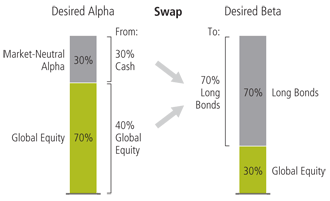Taking the Risk Out of Defined Benefit Pension Plans:
The Lure of LDI
September 30, 2008
Liability-driven investment has become one of the more fashionable phrases in the pensions world. LDI seems magically to square the circle between the sometimes-conflicting aims of pension funds: the short-term desire of sponsors to avoid deficits and the long-term demands of plan beneficiaries for a reliable income during retirement. But is LDI really a silver bullet which can cure all ills? Or is it actually a golden hammer—attractive but ultimately impractical?
We look at a number of LDI strategies and find many of the simpler approaches wanting. Pension fund buyouts look like the obvious answer but, while they solve the problem of longevity, they are expensive. “Immunizing” funds from interest rate movements is also superficially attractive. Interest rates are the single biggest factor in determining the size of pension fund accounting deficits, so investing in bonds should offset the risk. Yet bonds do not always reflect the real economic liabilities faced by pension funds, such as inflation, wage growth, longevity and length of service.
Swap overlays attempt to address this problem by using derivatives to neutralize the interest rate risk, while allowing a fund to stay in equities. The problem is that they can also wipe out the natural diversification benefits from a mixed portfolio of equities and bonds. Similarly, “costless” collars, in attempting to limit downside risk, tend to be costly in terms of the upside foregone.
Portable Alpha Combines Desired Beta with Better Alpha

We believe that a more sophisticated approach using portable alpha can overcome many of these problems. This technique allows the excess return (or alpha) available from, say, global equities or a market-neutral fund of hedge funds to be transferred to assets with a beta which moves more in line with the fund’s liabilities, such as bonds. The fund should thus be able to capture the returns it needs, without facing the risk of large accounting deficits.
But care is needed in choosing an alpha strategy. Investors in search of high-quality portable alpha should emphasize low correlation among return sources, be willing to employ leverage and consider dynamic asset allocation. They should also take a realistic attitude to the nature of alpha, which is not always consistent and is prone to short-term uncertainties and failures of diversification.